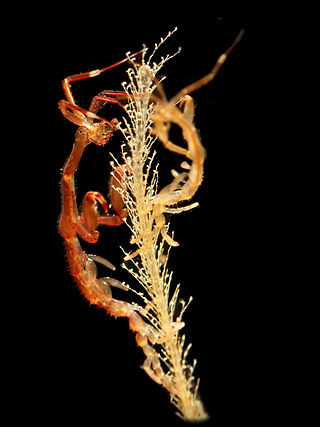
Nereis is a genus of polychaete worms in the family Nereididae. It comprises many species, most of which are marine. Nereis possess setae and parapodia for locomotion and gas exchange. They may have two types of setae, which are found on the parapodia. Acicular setae provide support. Locomotor setae are for crawling, and are the bristles that are visible on the exterior of the Polychaeta. They are cylindrical in shape, found not only in sandy areas, and they are adapted to burrow. They often cling to seagrass (posidonia) or other grass on rocks and sometimes gather in large groups.

Harmothoe is a genus of marine Polychaete worms belonging to the family Polynoidae. Species of Harmothoe are found world-wide to depths of at least 5,000 m but are more common in shallower water.

Tritonia is a genus of sea slugs, nudibranchs, shell-less marine gastropod molluscs in the family Tritoniidae.

Ampharetinae are a subfamily of terebellid "bristle worm". They are the largest subfamily of the Ampharetidae, of which they contain the great majority of the described genera.

Goniodoris is a genus of sea slugs, specifically dorid nudibranchs, marine gastropod molluscs in the family Goniodorididae.

Spintheridae is a family of marine polychaete worms with a single genus, Spinther, containing these species:

Acrocirridae is a family of polychaete worms. Acrocirrids are detritivores, catching falling particles with numerous long prostomial tentacles. There are eight known genera, and at least 21 described species and subspecies within the Acrocirridae. The acrocirrids are primarily benthic (seabed-dwelling) animals, but at least two genera appear to have evolved or adapted to a pelagic (free-swimming) habitat.

Ampharete is a genus of polychaete annelid worms. They have a single, chevron-shaped row of teeth.

The Bopyridae are a family of isopod crustaceans in the suborder Cymothoida. There are 1223 individual species contained in this family. Members of the family are ectoparasites of crabs and shrimp. They live in the gill cavities or under the carapace where they cause a noticeable swelling. Fossil crustaceans have occasionally been observed to have a similar characteristic bulge.

Caprella is a large genus of skeleton shrimps belonging to the subfamily Caprellinae of the family Caprellidae. It includes approximately 170 species. The genus was first established by Jean-Baptiste Lamarck in his great work Système des animaux sans vertèbres (1801) to describe Cancer linearis and Squilla ventricosa.

Antalis is a genus of tusk shells, marine scaphopod mollusks.

Owenia is a genus of marine polychaete worms in the family Oweniidae.

Eulalia is a genus of polychaete worms.

Phyllochaetopterus is a genus of marine polychaete worms that live in tubes that they construct.

Eunoe is a genus of marine annelids in the family Polynoidae. The genus includes 48 species which are found world-wide, mostly from depths of 50 m or more.

Flabelligeridae is a family of polychaete worms, known as bristle-cage worms, notable for their cephalic cage: long slender chaetae forming a fan-like arrangement surrounding the eversible head. Unlike many polychaetes, they also have large, pigmented, complex eyes.

Naineris is a genus of polychaete annelids belonging to the family Orbiniidae. It was first described by Henri Marie Ducrotay de Blainville in 1828. The type species is Nais quadricuspida Fabricius, 1780, currently accepted as Naineris quadricuspida. The genus has cosmopolitan distribution.
Amphitrite is a genus of polychaetes belonging to the family Terebellidae. The genus has cosmopolitan distribution.

Thelepus is a genus of polychaetes belonging to the family Terebellidae.
















